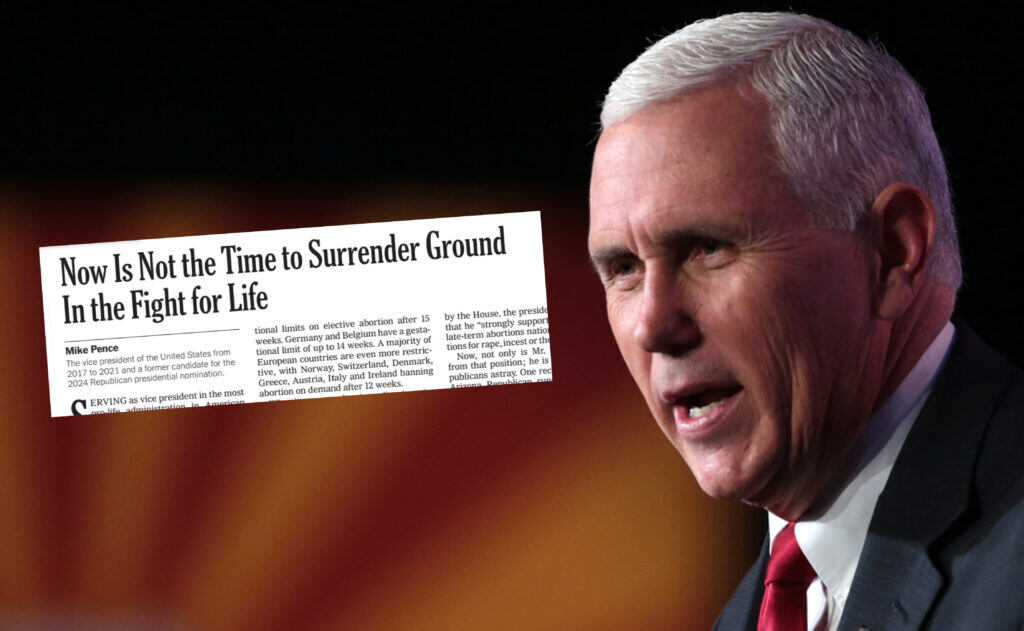
You Don’t Have to Publish Every Point of View
It’s indefensible for the New York Times to publish an argument against women’s basic human rights.
The New York Times print edition today carries an op-ed from former Vice President Mike Pence entitled “Now Is Not The Time To Surrender Ground in the Fight For Life.”1 In it, Pence says that helping to end Roe v. Wade was the proudest accomplishment of his time in office and calls to build on that achievement by enacting a nationwide prohibition on abortions after 15 weeks of pregnancy. The unborn are “created in the image of God, the same as you or me,” says Pence, who prays that Donald Trump “will rediscover the passion for life that defined our four years in office.”
The op-ed was, like most New York Times op-eds, not subject to any serious editorial scrutiny. The Times editors apparently let him say whatever he wanted, even when it was so misleading as to be outright propaganda.2 For instance, Pence repeats the common Republican talking point that European countries supposedly have harsher abortion policies than the United states does. He says that countries like Norway and Denmark “[ban] abortion on demand after 12 weeks,” meaning that existing U.S. abortion rights across states place us on the “radical fringe.” A 15-week ban, he says, would bring us into the “mainstream of Western thought and jurisprudence.” Right now, he argues, we are more like “communist China and North Korea.”

It is outright false, however, to say that putting a 15-week abortion ban in place would bring the United States toward the “mainstream of Western thought,” meaning in line with Europe. Most of the European countries Pence cites have widespread easy abortion access. As Carole Joffe, a scholar who studies abortion laws (and whom I interviewed for Current Affairs a while back), wrote in an article comparing the U.S. and Norway, the two countries are indeed “on different planets” when it comes to abortion. But not because Norway is more strict! Rather, because Norway actually takes a woman’s right to choose seriously. Abortion, she writes, is “completely integrated into the Norwegian health care system, paid for (like other medical procedures) by the government, and available virtually everywhere in the country.” In Norway, “OB/GYN residents are expected to undergo training in abortion provision, and though opt-out provisions exist, very few young physicians make use of them.” The United States only looks more liberal than Norway “on paper,” she says, because abortions between 12 and 18 weeks of pregnancy have to be approved by a medical review board, and above 18 weeks can only be conducted to protect the mother’s health or life, or in case of serious fetal abnormalities. But it is much harder for women to get an abortion in the United States (as Joffe and David S. Cohen show in their book Obstacle Course) than in a country where abortion is “freely available, subsidized by the government, and apparently not stigmatized.”
So Pence is lying when he says that a 15-week ban would bring the U.S. in line with European policies. To align the U.S. with Denmark, for instance, abortion would need to be paid for by the state, which Pence completely opposes (his op-ed warns that some Democrats want “taxpayer-funded abortions up to the moment of birth.”) It’s true that European countries generally require no-questions abortions to be performed early in a pregnancy, but that requirement is only made humane by the fact that the procedure is easy to get. Restrictions are made not to matter very much by the other policies that exist alongside them such as prenatal healthcare, maternity leave, and child care. (Some European countries are moving toward greater liberalization, another fact Pence doesn’t mention.) Pence doesn’t really want European abortion policies, he wants to put in as many restrictions as possible and to destroy women’s ability to actually access abortions in practice.
Why would the New York Times give Mike Pence space to offer this misleading bullshit, in which he falsely presents himself as offering moderation and compromise? Well, the New York Times has long had a policy of publishing what it considers a broad range of points of view, in part to push back against the accusation that it is a liberal publication. So while the editorial board are broadly sympathetic to Democrats, you’ll occasionally see pieces like John Bolton’s “To Stop Iran’s Bomb, Bomb Iran.” Four years ago, there was a controversy about the practice of putting occasional reactionaries in, because the Times published an op-ed from Senator Tom Cotton in which he called for the use of military force against Black Lives Matter protesters. The editor at the time, James Bennet, ultimately resigned, and he presents the case as an example of the “progressive elite” wanting an insular echo chamber rather than a culture of viewpoint diversity. He argued that the Times “owes it to our readers to show them counter-arguments, particularly those made by people in a position to set policy.”
But as I argued at the time, this is the wrong view of what a paper’s op-ed page should do. Should a paper in the 1900s have published a pro-lynching editorial by “Pitchfork” Ben Tillman, just because he was a U.S. senator and is “in a position to set policy”? If a Nazi becomes a state governor, should they get an op-ed in the New York Times because they’re powerful? A newspaper’s editorial page is not a forum for all conceivable opinions, no matter how dangerous and ignorant. Its editors have to make judgments about which opinions are within the range of what ought to be publicly debatable. They have a duty to shape the public debate, not just present it as it is or as what the rich and powerful say it is. If the public debate is over whether, say, slavery is bad (which was indeed once hotly debated!), a newspaper’s editorial page should crusade against slavery, not maintain “objectivity” and balance.

The New York Times editors know this, and would never, I assume, publish an op-ed in favor of Holocaust denial (although the paper’s record during the actual Holocaust was atrocious). They consider certain toxic views outside the boundaries of reasonable discussion. As James Bennet said, viewpoint diversity “doesn’t mean letting any opinion into the debate” since there’s “no place for bigotry or dishonesty in intelligent discussion.” But that means that by deciding what to put in the op-ed page, you’re essentially determining what constitutes“intelligent discussion.” And that means the Times editors have decided that the idea of denying women their basic constitutional rights (or what were their constitutional rights, until they were stripped away thanks to Pence and his cronies) is debatable. Not only that, but it’s considered acceptable to allow entirely misleading, essentially false representations of other countries’ practices on abortion to be presented. A responsible editor, of course, would have asked Pence why he wasn’t noting that European countries also have supportive family leave and child care policies that make the prospect of having a child less terrifying, and see abortion as a basic medical procedure. The only reason that Pence didn’t note these things is that he’s a propagandist who wants Americans to have a false impression of the world. And the Times editors are happy to help him in his mission. Presumably, if the Christian nationalists continue to gain ground in their mission to take us back to the 19th century, we can expect to see arguments for repealing women’s suffrage (perhaps because on the grounds that it’s bad for capitalism, as Peter Thiel says).
It was right for the editor of the Times op-ed page to be forced out in 2020 over the Cotton op-ed. When editors make bad judgments, they should face consequences. But, unfortunately, the op-ed pages are still filled with a lot of crap, with roughly the same philosophy being followed as before. The current editors have decided that more space should be devoted to columnist Pamela Paul explaining why she didn’t like Barbie and college kids need manners than to the voices of the “unpeople” in the majority of the world’s countries. They decided that it’s valuable for women to read an argument that they should be thrown in prison if they have an abortion after 15 weeks of pregnancy, which is presented as some kind of moderate position (Pence does not say he supports any exceptions to the cutoff). This is a disgraceful thing to print. It can’t be justified on grounds of “viewpoint diversity,” and the editor (Kathleen Kingsbury) should resign just like Bennet did, because clearly nothing has been learned.
I run a publication myself (a much better one, that you should subscribe to and support instead of the Times, which is rolling in money thanks to Wordle and fossil fuel sponsorships). This means I think a lot about how much you ought to agree with a piece of writing in order to publish it. Obviously, you’re never going to agree with every single word, and you want some contenting points of view to avoid being boring and predictable. But the writing should make an argument worth hearing, one whose existence contributes positively to public discussion. That’s a subjective judgment, but subjective judgments are unavoidable when you edit opinion pieces. It’s okay not to publish everything, because a newspaper or magazine is not the government. It’s allowed to, and should, have a point of view. Newspapers on the right like the Wall Street Journal are perfectly comfortable with being opinionated, and they’re right that this is a prerogative. (It’s just that the opinions themselves are evil.) I also try to make sure that the pieces we publish aren’t propaganda. If there’s a counterargument, you must address it rather than burying it. The New York Times should only publish pro-abortion editorials, but it should make sure that those editorial accurately represent the anti-abortion position, quoting its proponents fairly and considering their strongest points. There is just no excuse for publishing material that is misleading as well as morally reprehensible.
Note: the op-ed first ran online on April 20 with a title that emphasized criticism of Donald Trump, but received a different title for the print edition. ↩
Elsewhere in the paper, editing is not nearly so lax for reporters trying to use the forbidden word “Palestine.” ↩




